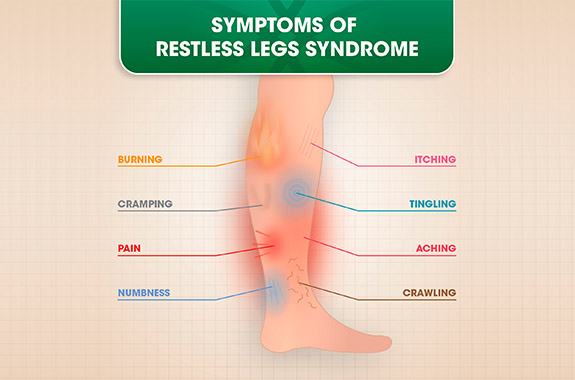
What are common signs and symptoms of restless legs?
People with RLS feel the irresistible urge to move, which is accompanied by uncomfortable sensations in their lower limbs that are unlike normal sensations experienced by people without the disorder. The sensations in their legs are often difficult to define but may be described as aching throbbing, pulling, itching, crawling, or creeping. These sensations less commonly affect the arms, and rarely the chest or head. Although the sensations can occur on just one side of the body, they most often affect both sides. They can also alternate between sides. The sensations range in severity from uncomfortable to irritating to painful.
Because moving the legs (or other affected parts of the body) relieves the discomfort, people with RLS often keep their legs in motion to minimize or prevent the sensations. They may pace the floor, constantly move their legs while sitting, and toss and turn in bed.
A classic feature of RLS is that the symptoms are worse at night with a distinct symptom-free period in the early morning, allowing for more refreshing sleep at that time. Some people with RLS have difficulty falling asleep and staying asleep. They may also note a worsening of symptoms if their sleep is further reduced by events or activity.
RLS symptoms may vary from day to day, in severity and frequency, and from person to person. In moderately severe cases, symptoms occur only once or twice a week but often result in significant delay of sleep onset, with some disruption of daytime function. In severe cases of RLS, the symptoms occur more than twice a week and result in burdensome interruption of sleep and impairment of daytime function.
People with RLS can sometimes experience remissions—spontaneous improvement over a period of weeks or months before symptoms reappear—usually during the early stages of the disorder. In general, however, symptoms become more severe over time.
People who have both RLS and an associated medical condition tend to develop more severe symptoms rapidly. In contrast, those who have RLS that is not related to any other condition show a very slow progression of the disorder, particularly if they experience onset at an early age; many years may pass before symptoms occur regularly.